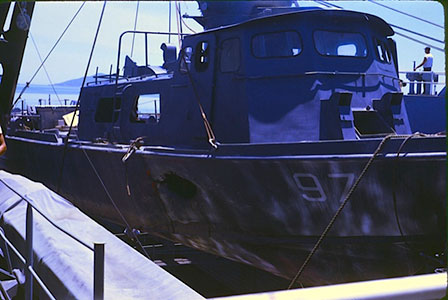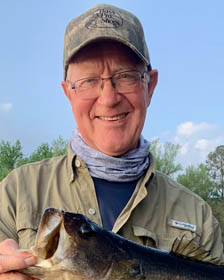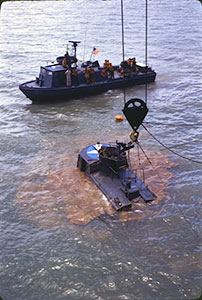Navy Vietnam War Lombard, IL Flight date: 06/19/24
By Mark Splitstone, Honor Flight Chicago Veteran Interview Volunteer
Bob Walker’s father was a career Navy man who served on a minesweeper clearing obstacles before D-Day and then spent the days after the invasion recovering bodies and parts of bodies from the water. Bob was born in San Diego in 1947 and as a Navy brat moved around a lot, including an extended stint in Japan. When Bob was five-years-old, his father was transferred to Naval Station Great Lakes, enabling him to return to his hometown of Chicago. Bob and his brother were both strong swimmers and he recalls that when his father was assigned to instruct non-qualified swimmers, he would sometimes use the two brothers as motivation for the recruits.
Bob graduated from Oak Lawn Community High School in 1965 and then went to work at Goldblatt’s department store. After a year there, the Vietnam War was heating up, and Bob decided he didn’t want to risk getting drafted into the Army, so instead he volunteered for the Navy. By this point, his father had retired from service, but his older brother had enlisted. Bob joined the Navy in June 1966.
Bob initially wanted to be a Navy pilot and was accepted into Naval ROTC at New Mexico State University, but those plans fell through due to tight family finances. Instead, he went to boot camp at Naval Station Great Lakes, the same place where years earlier he had helped his dad teach recruits how to swim. After boot camp, his initial plan was to be a naval electronics technician, but since that required a six-year commitment, he instead went to A school to be qualified as a gunner’s mate. He requested to serve in the Atlantic, but he and everyone else from his class who requested this posting were instead assigned to Vietnam.
In 1965, in response to the fighting conditions in Vietnam, the US Navy had formalized a “brown water” navy for the first time since the Civil War. Its purpose was to patrol the inland waterways of the Mekong Delta, using several different types of boats, most famously the Swift Boat. Swift Boats were fast and well-armed, but as Bob would find out, their aluminum skin did not provide much protection. Bob was sent to Coronado, California to train on this vessel, and while in California he also did SERE (Survival, Evasion, Resistance, and Escape) training, which he says was very tough and physically demanding.
Bob was stationed at a naval base in Cat Lo, on the southeast coast of Vietnam. The Navy was in the midst of conducting Operation Market Time, which was an effort to halt the flow of troops and supplies into South Vietnam by stopping and searching any Vietnamese boats they encountered. Whenever they stopped a Vietnamese boat, one or two men would board and search it while the rest of the crew of six would keep their weapons trained on the people on the boat. Bob was usually stationed at the twin 50-caliber machine guns near the front of the boat. Occasionally, the Vietnamese boat would try to flee and the Swift Boats would give chase, but this was the exception. In most cases, the occupants of the Vietnamese boats were just fishermen trying to feed their families, but sometimes they’d have Vietcong hidden among them. Whenever they found suspicious characters, they would turn them over to the South Vietnam navy, in part because in most cases nobody on the Swift Boats spoke Vietnamese.






Bob has other memories from Vietnam, such as when a B-52 crashed in the South China Sea during a monsoon and Bob’s boat was sent to search for survivors. The seas were exceptionally rough, and they never found anyone. Occasionally they’d be asked to provide fire support for army units who had pushed Vietcong units toward the coast. Because of the risk of friendly fire incidents, these attempts were often called off because of the inaccuracy of the Swift Boat weaponry when firing at long distances in choppy seas. He also recalls a time when their Swift Boat screws became entangled in some fishing nets. As the best swimmer in the crew, Bob was sent underwater to disentangle them. When he saw a venomous sea snake swimming toward him he says he managed to get from five feet underwater to the deck in approximately “half a millisecond.” He also recalls that there was a small, marshy island opposite the base at Cat Lo on which snipers would sometimes hide in the reeds. Eventually, the island was sprayed with Agent Orange which destroyed all the vegetation.
On June 25, 1967, Bob’s Swift Boat was ordered up a river because of reports of significant sampan activity. When they reached the location they were almost immediately ambushed. A rocket penetrated the boat near the bow, resulting in Bob receiving a shrapnel injury in his hip and the boat officer having most of his shoulder blown off. The boat officer was incapacitated, but Bob managed to get the boat underway and raced back down the river, pursued by enemy sampans. Both of the main radios had been damaged, but a new, small radio had recently been installed. They put out a distress call as the boat started sinking, and fortunately another Swift Boat happened to be nearby. As the boat sank, Bob helped several crew members into life rafts before climbing aboard himself. He’s thankful that the third radio worked and that another Swift Boat was nearby. If not, he and his crew would’ve almost certainly been killed or captured. While Bob credits their survival to luck, his boat officer credits his survival to Bob. The citation for Bob’s Bronze Star reads “By the exceptional performance despite his wounds, Seaman Walker served as an inspiration to his entire division.”
Decades later, the son of a sailor who had served on a salvage ship tracked down Bob and sent him photos of the recovery of his Swift Boat. One photo shows the boat being pulled out of the ocean, while the other shows the hole caused by the rocket, which was directly below where Bob had been standing.
Bob spent two days in the hospital and then went back to Cat Lo where he joined a different Swift Boat with a different crew. After one year in Vietnam, he was assigned to a naval base in Naples, Italy, where he served for three years. Upon returning to the United States Bob joined the Naval Reserve, and between that and his active duty he served in the Navy for a total of six years before leaving the Reserve in 1972.
Bob returned to Chicago and studied electronics at DeVry with financial support from the GI Bill. He then worked for a small electronics firm for a while and then got a job doing communications work for the Illinois Central Railroad. He started in 1973 and wound up working there for 36 years. As a communications professional, he says he had a fabulous career, starting with teletype machines that had been manufactured in the late 1930s and transitioning all the way to cell phones.
One night while still in Navy training in the mid-1960s, Bob and a friend went to a bowling alley in Oak Lawn. Even though the facility was nearly empty, they were assigned to a lane right next to two young women. The four of them decided to pair up into two boy/girl teams. One of the girls, Nancy, originally wanted to be on the team with Bob’s friend but says she “got stuck with Bob.” They began dating, but shortly thereafter Bob was sent to Vietnam. They wrote to each other frequently while he was there but were only able to speak to each other once. It was on a “MARS” radio phone which required them to complete each statement with “Over” and they both recall saying, “I love you. Over” and “I love you too. Over.” In the weeks between his tours in Vietnam and Naples, they were married. The boat captain whose life he saved attended their wedding. Nancy had only been out of Chicago one time in her life, but she accompanied him to Naples and they’ve been together ever since. They’ve had a wonderful journey together, from traveling around Europe and camping when Bob was stationed in Naples, to vacations around the world, to raising three children.
Bob retired from the railroad in 2010. He and Nancy have lived in the same house in Lombard for nearly fifty years and have no plans to move. He explains that there are three phases of retirement: It starts as go-go, then comes slow-go, and finally no-go. He says that he and Nancy are coming to the end of slow-go. He’s had to give up some of his favorite activities, like scuba diving, but still likes to spend time with his three kids and five grandkids, and he and Nancy are still able to travel to see family in Florida. Despite health issues and some lingering effects from Vietnam, Bob feels very fortunate and very blessed.


